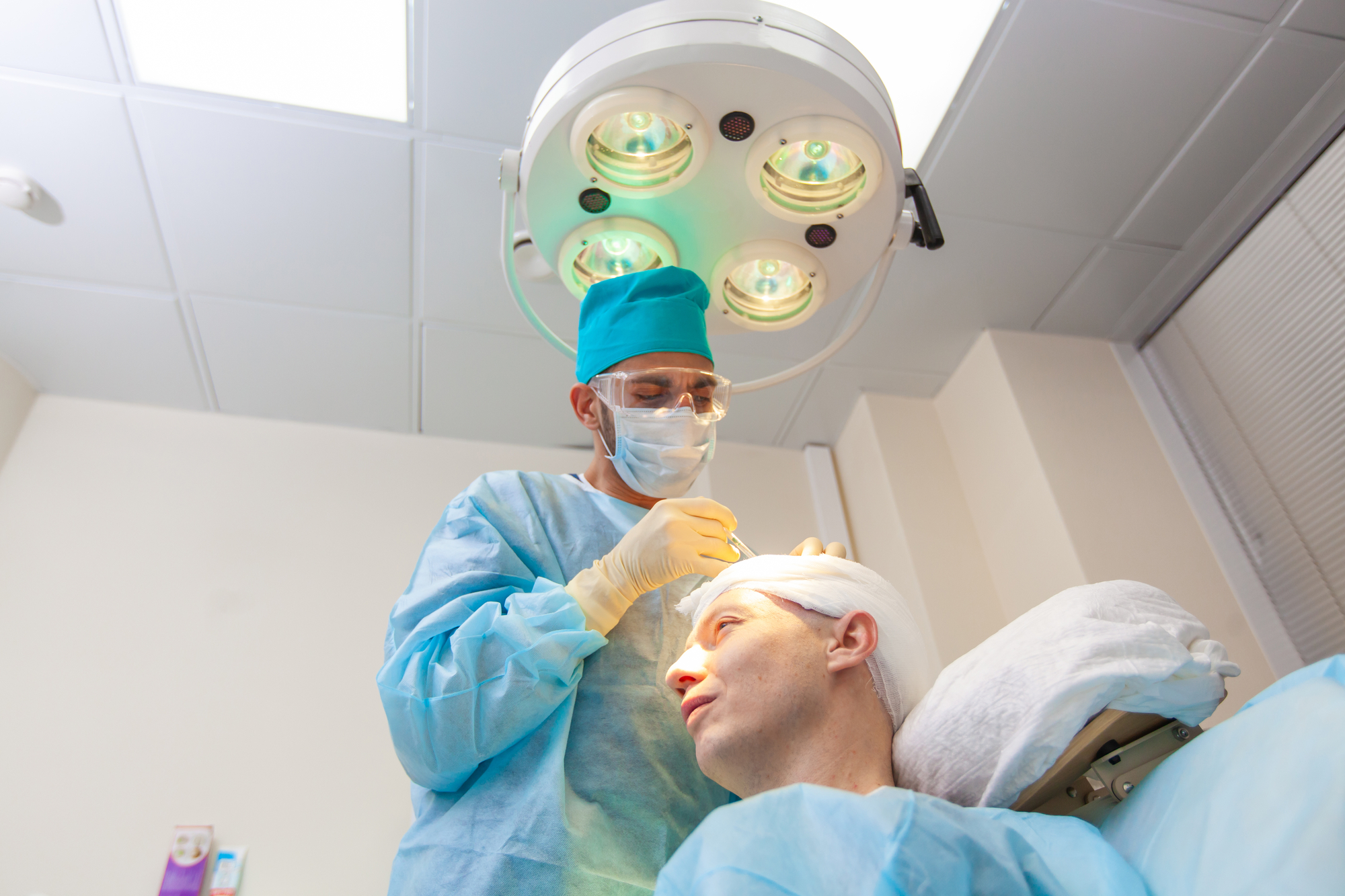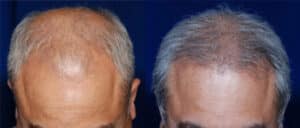Have you noticed that your hair is rapidly thinning? This is a condition that can affect both men and women, and it can occur at any age.
There are many different factors that can contribute to hair loss, ranging from heredity and hormonal changes to medical conditions and aging. The symptoms can be both physical and psychological in nature, often leading to feelings of embarrassment and anxiety.
Thankfully, there are surgical treatments designed to help restore your appearance and self-esteem. One of those is a hair transplant.
How does a hair transplant work, and what does it entail? Today, we’re taking a closer look and sharing the steps involved in this transformative procedure.
What Is a Hair Transplant?
Before we dive into how this type of surgery works, let’s start with a general overview.
In short, hair transplantation typically involves surgically removing grafts of hair-bearing scalp from a donor area and relocating them to a balding or thinning area of the scalp (recipient area). These grafts can be removed as small, individual pieces (called punch grafts) or they may be one big piece, later cut into small pieces.
This type of hair restoration surgery is called Follicular Unit Extraction (FUE).
The punch grafts can be differently shaped and sized. The shape of each one usually dictates how many hairs it will contain. Here’s a quick estimate:
- Micro-grafts: Around one to two hairs
- Small mini-grafts: Around two to four hairs
- Slit grafts (inserted into scalp slits): Around four to 10 hairs
- Round-shaped grafts: Around 10 to 15 hairs
- Long strip grafts: Around 30 to 40 hairs
How will your doctor know which type of graft to use? This is based on the total amount of coverage that you need, which can hinge on two main factors. These include:
- The color of your hair
- The texture of your hair
If your hair is fine and dark, you’ll need a different approach than someone with thick, gray, or blonde hair. Most patients receive around 50 large plugs in their first session alone, though this number can vary from person to person. If your doctor uses mini-grafts or micro-grafts, the number of initial plugs can be in the hundreds.
Grafting Techniques
If your physician determines that this surgical procedure is right for you, there are a few different techniques that they can employ. Let’s take a look at each one.
Punch Grafts
Punch grafts are small, round pieces of hair-bearing scalp. Your doctor can remove them from the donor area of your scalp using a surgical instrument shaped like a tube.
The carbon steel instrument has sharp ends and can be used to precisely punch the graft out of the site.
Then, your doctor can use those grafts to replace the scalp in the area you want to cover. Punch grafts are often used to treat thinning areas along the frontal hairline.
Larger Grafts
If punch grafts aren’t appropriate in your case, your doctor will use a different instrument called a scalpel to remove a larger section of hair-bearing scalp from your donor area.
While these are technically “larger” than the punch grafts, they are still relatively small. Yet, removing them can affect the strength of the surrounding skin on your scalp. To fortify those areas, your doctor may inject small amounts of saline solution into your scalp.
Once the grafts are removed, your doctor will divide them into tiny sections. Then, they will transplant those grafts into small holes or slits within your scalp.
How Does a Hair Transplant Work? Step-by-Step Guide to PUE Transplants
There are a few different types of hair transplant surgery, which we’ll describe below. However, FUE remains one of the most common. Let’s take a look at how it works, step by step.
Pre-Surgery: Determining Candidacy
Before your doctor performs any type of hair transplant surgery, they’ll need to make sure you’re a qualified candidate for this procedure. While candidates should have some noticeable hair loss, they should also have areas of healthy hair growth that can serve as donor areas.
Most of the time, these areas will be located at the back and sides of the patient’s head.
Step 1: Taking Pictures
First, your doctor will take medical photographs of your head and scalp, using a special camera. You will be asked to hold your head in pre-defined positions, so the medical team can accurately capture your “before” appearance.
Step 2: Marking the Donor and Recipient Areas
Next, your doctor will mark the areas on your scalp where the donor tissue will come from. Then, they will mark the recipient areas. At this point, they may fully or partially shave the donor area.
Step 3: Extracting the Follicular Units
Once the areas are marked, your doctor will apply local anesthesia at the pre-marked donor area on your scalp.
Using millimetric surgical instruments called punches, they will cut the follicular units from the donor area. They will remove those units using very small, precise forceps.
Step 4: Preparing the Follicular Units
To keep the follicular units vital and healthy, your doctor will place them in a special solution as soon as they extract them.
While your doctor continues the extraction process, another team member will begin to prepare the follicular units. To do so, they’ll look at the units under a stereoscopic microscope.
For the entire length of time that the follicular units are outside of your body, they must be appropriately preserved and protected. The surgical team will ensure that they remain properly hydrated and under strict temperature control up until the exact moment of implantation.
After the extraction is complete, most teams will allow patients to have a short lunch break before implanting begins.
Step 5: Implanting the Follicular Units
When it’s time to implant the follicular units, your doctor will apply local anesthesia to the recipient area of your scalp. They will also make microscopic orifices where the follicular units will be implanted.
To make these small incisions, they must be very precise, using a needle with a thickness of less than one millimeter. They will measure how deep to make the incision based on the exact length of the follicular unit.
Once the incisions are made, your doctor will use a precision instrument called an implanter to carefully place the follicular units into each recipient area. The application will follow the direction and angle of natural hair growth.
Post-Surgery Recovery
At the end of each grafting session, your doctor will clean your scalp and cover it with gauze. They may also require you to wear a special pressure bandage for a few days.
You might be surprised to find that a majority of the transplanted hairs will fall out around three to six weeks post-surgery. That’s a natural occurrence, and the most important thing is that their roots will remain in the scalp.
New hair will grow from these roots. You can expect to see that new growth between three and four months after the procedure.
Subsequent Grafting Sessions
If you choose an FUE hair transplant to treat hair loss, it’s important to understand your anticipated timeline. Most of the time, patients require multiple surgical sessions before their hair reaches the desired fullness. In all, a full transplant series normally takes up to two years to achieve the final result.
Other Types of Hair Transplant Surgery
There are other types of hair transplant surgery in addition to FUE. Let’s review a few of the most common ones.
Tissue Expansion
If you’re losing hair, your doctor may also recommend a tissue expansion. Plastic surgeons commonly perform this type of surgery, but it’s mostly reserved for burn patients who suffer skin loss as a result of their wounds and injuries.
To perform this procedure on your scalp, your doctor will use a device called a tissue expander, which is shaped like a balloon. First, they will locate an area of your hair-bearing scalp that’s located adjacent to a bald or thinning area. Then, they will insert the expander beneath the hair-bearing portion.
Slowly, they will fill and inflate the expander with salt water, usually over the course of several weeks. In time, the skin will slowly expand under the pressure, catalyzing the growth of new skin cells. Eventually, a bulge will form beneath the surface of your scalp.
It typically takes about two months for your skin to adequately stretch out. Once that occurs, your doctor will perform another surgery, this time re-positioning the newly expanded skin to cover the bald area beside it.
Flap Surgery
While scalp grafting is a commonly used procedure, it isn’t the only type of hair transplant surgery available. Flap surgery is another one.
Your doctor may recommend this treatment if you have large sections of baldness on your scalp that you need to quickly cover. In all, one flap can cover as much area as at least 350 individual punch grafts.
While your doctor will tailor the process according to your exact needs, the basic steps are the same for everyone.
First, they will cut out a section of your bald scalp. Then, they will lift a flap of hair-bearing skin from the surface, leaving one end still attached. This forms the “flap.”
Next, they will gently position the flap over your section of bald scalp and sew it into place. Throughout this process, the flap remains partially attached at its original location, which keeps its blood supply intact. The scar that forms as a result of this surgery is usually concealed by new hair growth.
Scalp Reduction Surgery
Are you dealing with a bald crown? If you’re losing hair at the top or back of your head, your doctor may recommend a type of advanced flap surgery called scalp bearing.
In this procedure, they will pull sections of your hair-bearing scalp forward to cover the bald area.
First, they’ll inject your scalp with a local anesthetic, then remove a portion of your bald scalp. Then, they’ll loosen and pull the skin surrounding that excised area. This allows them to bring the sections of your hair-bearing scalp together, effectively closing up the bald portion.
Once the procedure is complete, they’ll close the area with stitches.
Learn More About Hair Transplant Surgery
If you’re dealing with hair loss, you naturally want to do anything you can to reverse the effects and reclaim your quality of life.
How does a hair transplant work? As you can see, there are a few different ways it can be performed! Regardless of the specific procedure your doctor recommends, the end result will be one that renews your confidence and restores the look of healthy, full hair.
Are you interested in learning more about this treatment? Contact us today to schedule a consultation!




